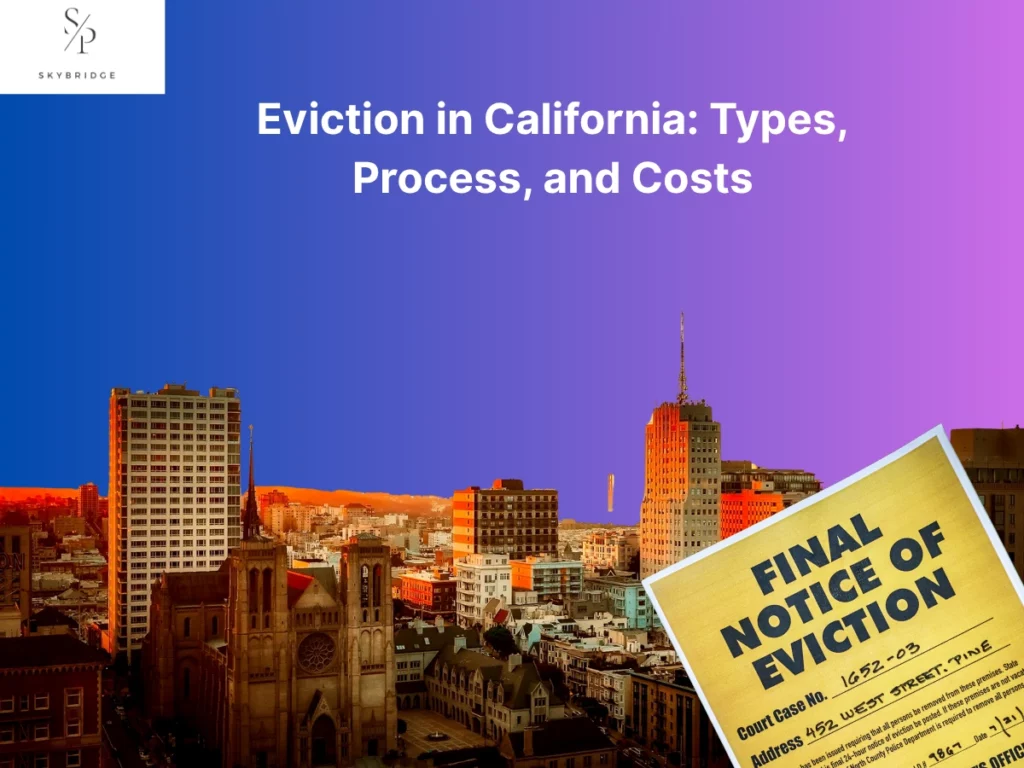In California, the eviction process begins with an unlawful detainer lawsuit when a tenant fails to comply with their lease terms, such as non-payment of rent or violation of rental agreements. This legal action is essential for landlords to regain possession of their property. Understanding the types of evictions, the process, and the associated costs is crucial for both landlords and tenants to navigate the situation legally and effectively.
California law defines two primary types of eviction: at-fault evictions occur when tenants breach their lease, such as failing to pay rent or causing damage to the property, and no-fault evictions arise when landlords need to reclaim the property for reasons like personal use or significant renovations. The California Civil Code Section 1946.2 outlines the legal grounds for eviction and protects tenants from unjust removals, ensuring that both parties adhere to a strict legal process.
Eviction can be costly for landlords, and understanding these expenses is essential. Filing fees, sheriff enforcement fees, and attorney fees may add to the financial burden. Landlords may also face additional costs like property repairs, lost rent, and cleaning fees. With a clear understanding of the eviction process, including tenant rights under laws like the Fair Housing Act and California Rent Control Laws, both parties can avoid legal pitfalls and reach a fair resolution.
What is Eviction?
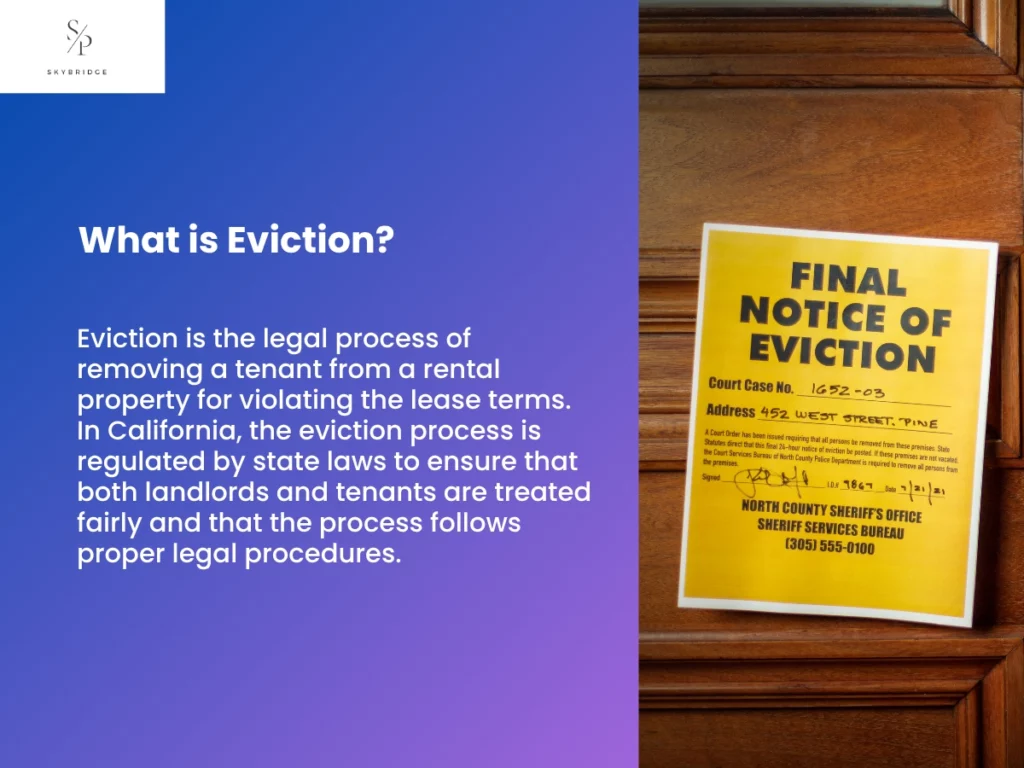
Eviction is the legal process of removing a tenant from a rental property for violating the lease terms. In California, the eviction process is regulated by state laws to ensure that both landlords and tenants are treated fairly and that the process follows proper legal procedures.
The eviction process starts when the landlord serves the tenant with a formal notice, such as a 3-Day Notice to Pay Rent or Quit for unpaid rent or a 30/60-Day Notice to Quit for no-fault evictions. If the tenant fails to comply with the notice, the landlord can file an unlawful detainer lawsuit in court. The court will review the case, and if the landlord’s eviction request is valid, the court will issue a judgment for eviction. In some cases, tenants may contest the eviction in court, and if the tenant refuses to leave after the judgment, the landlord can request a Writ of Possession, allowing law enforcement to remove the tenant from the property.
What are the Different Types of Evictions in California?
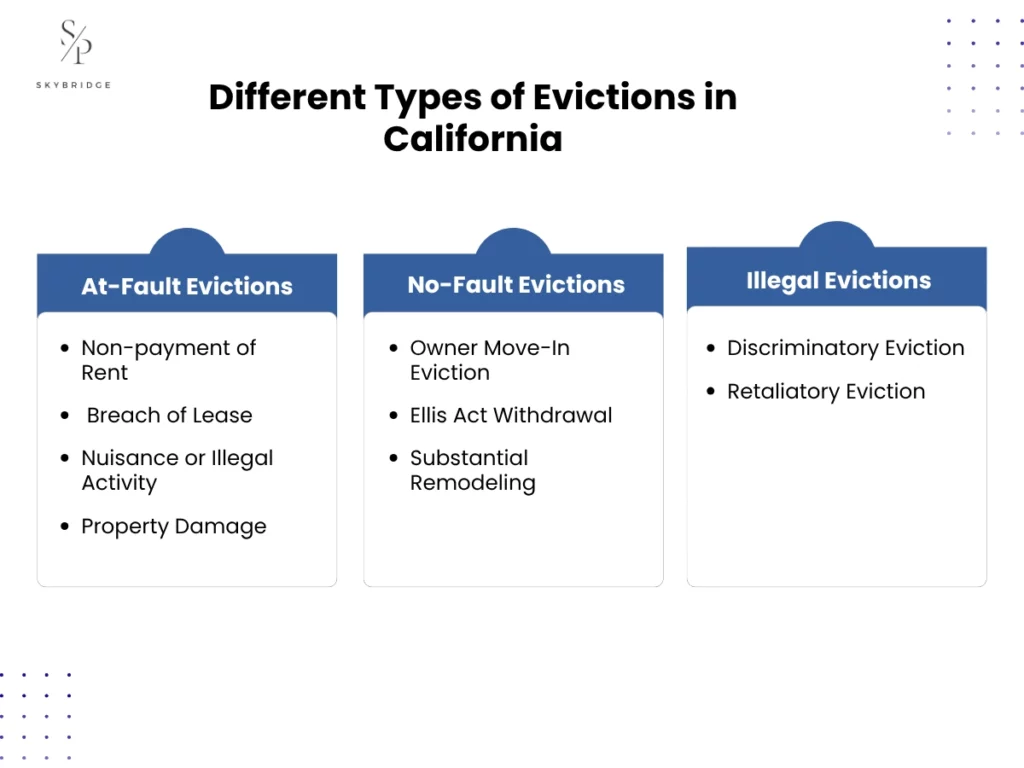
California recognizes At-Fault Evictions, No-Fault Evictions, and Illegal Evictions, each with distinct legal grounds and requirements that landlords must follow to ensure a lawful process. Understanding these types is essential for both landlords and tenants, as the process, notice periods, and legal implications differ for each. Landlords must ensure they follow the correct procedures for each type to avoid potential legal disputes or penalties. Similarly, tenants must be aware of their rights to protect themselves from unlawful removal.
At-Fault Evictions
An eviction is considered At-Fault when a tenant violates specific terms of the lease agreement. California law specifically outlines legal grounds for such evictions, and landlords must follow appropriate procedures to avoid legal issues. These violations include non-payment of rent, property damage, or illegal activities occurring on the premises.
- Non-payment of Rent:
If a tenant does not pay rent, the landlord must serve a 3-Day Notice to Pay Rent or Quit under California Code of Civil Procedure (CCP) Section 1161(2). If the tenant fails to comply within the 3 days, the landlord can proceed with filing an unlawful detainer lawsuit. If the tenant pays before the end of the 3 days, the eviction is canceled. - Breach of Lease:
For violations such as unauthorized subletting or keeping pets when prohibited, landlords must issue a 3-Day Notice to Cure or Quit, as required under California Code of Civil Procedure Section 1161(3). This notice gives the tenant 3 days to correct the breach or vacate the premises. - Nuisance or Illegal Activity:
If the tenant’s actions, such as engaging in criminal activity or disturbing the peace, create a nuisance, the landlord can issue a 3-Day Unconditional Quit Notice as prescribed by California Civil Code Section 1946.2. This notice does not allow the tenant to cure the violation. - Property Damage:
Significant damage to the property beyond normal wear and tear may result in a 3-Day Notice to Cure or Quit, which demands repair or the tenant’s departure. California Civil Code Section 1946.2 also applies here, ensuring the tenant is given a proper opportunity to resolve the issue.
California law requires landlords to follow these legal steps to avoid claims of unlawful eviction. Suppose the tenant fails to remedy the violation within the notice period. In that case, the landlord can file an unlawful detainer lawsuit in court, where the judge will review the case and issue a ruling.
No-Fault Evictions
When a landlord evicts a tenant for reasons unrelated to their actions, it is called a No-Fault Eviction. This type of eviction typically occurs when the landlord wants to reclaim the property for personal use, such as moving in themselves or for major renovations. These evictions are governed by Civil Code Section 1946.2 and the Ellis Act (Government Code Section 7060 et seq.), which outline specific conditions and protections for tenants.
- Owner Move-In Eviction:
A landlord may evict a tenant to move in themselves or to make way for a close family member. In this case, the landlord must provide a 30-day Notice if the tenant has lived in the unit for less than one year, or a 60-day Notice if the tenant has lived there for more than a year. The notice must clearly state the intention of the landlord or family member to occupy the unit. - Ellis Act Withdrawal:
This law allows landlords to exit the rental business entirely by evicting all tenants and removing the property from the rental market. Landlords must serve a 60-Day Notice to Quit, which allows tenants to vacate the unit. However, tenants in rent-controlled areas may be entitled to relocation assistance as stipulated by local ordinances, particularly in cities like Los Angeles. - Substantial Remodeling:
When a landlord needs to conduct significant renovations that would make the property uninhabitable for the tenant, a 30- or 60-day Notice is required, depending on the tenant’s length of stay. The landlord must also provide evidence that the property will be uninhabitable during the renovations.
In all cases of No-Fault Evictions, tenants are generally entitled to protections under local rent control laws. For example, rent control ordinances in cities like Los Angeles require additional tenant protections, including relocation assistance and the possibility of rehousing. Landlords must comply with these regulations, and tenants have the right to challenge the eviction if proper procedures are not followed.
Illegal Evictions
An Illegal Eviction occurs when a landlord attempts to remove a tenant without following the proper legal procedures or for reasons prohibited by law. These evictions violate both state and federal laws, which provide strong protections for tenants against unlawful removal.
- Discriminatory Eviction:
Under the Fair Housing Act (Title VIII of the Civil Rights Act of 1968) and California Fair Employment and Housing Act (FEHA), landlords cannot evict tenants based on race, color, national origin, religion, gender, familial status, disability, or sexual orientation. Violating these protections exposes the landlord to legal consequences, including fines and damages. Tenants who experience discriminatory evictions have the right to file complaints with the Department of Housing and Urban Development (HUD) or take legal action in court. - Retaliatory Eviction:
According to California Civil Code Section 1942.5, landlords cannot evict tenants in retaliation for exercising their legal rights, such as filing complaints about unsafe living conditions or requesting repairs. If a tenant has raised concerns about the habitability of the property, the landlord cannot initiate eviction in response. If retaliation is suspected, tenants can file claims in court, and they may be entitled to damages, including compensation for legal fees.
Illegal evictions violate tenants’ rights, and tenants have a right to contest such actions in court. If an eviction is found to be illegal, the tenant may be awarded damages, including compensation for emotional distress, lost rent, and attorney fees. In some cases, the landlord may be required to pay for the tenant’s relocation costs and legal expenses.
Tenants facing illegal evictions should act promptly, gathering evidence of retaliation or discrimination, and consult legal counsel to protect their rights and seek damages where applicable.
What is the Step-By-Step Process for Eviction in California?
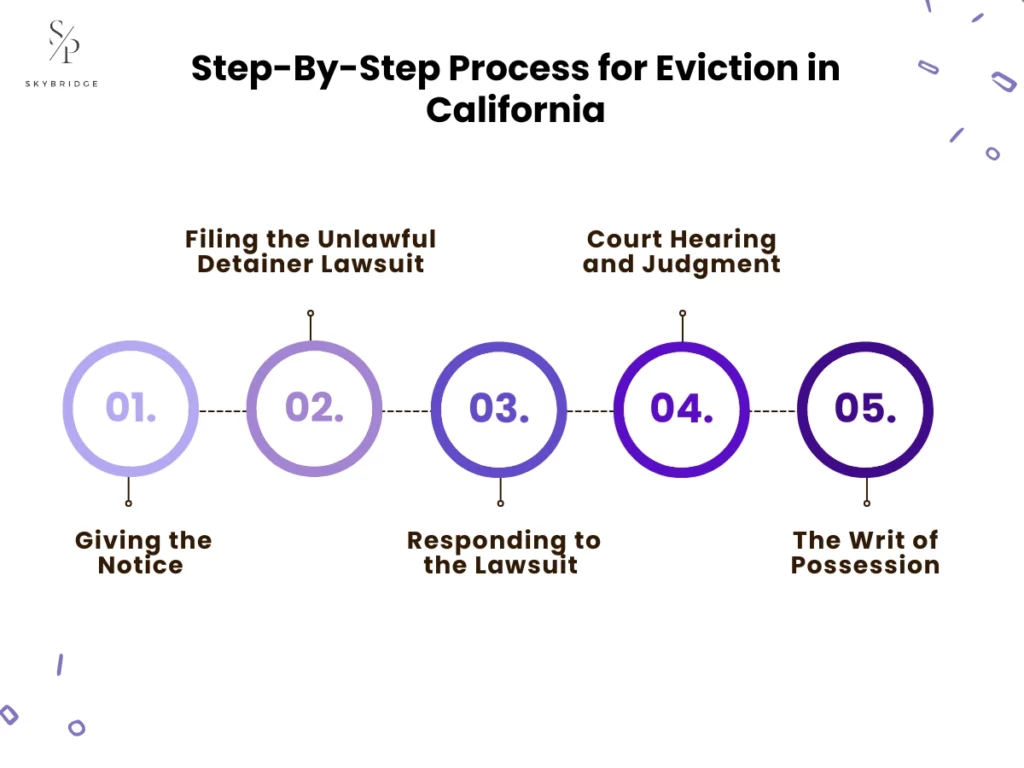
The eviction process in California follows a structured legal procedure designed to protect the rights of both tenants and landlords. Each step in the process is carefully regulated by law to ensure fairness and compliance. Below is an overview of the key steps involved in an eviction, from giving notice to obtaining a Writ of Possession.
Step 1: Giving the Notice
The first step in the eviction process is giving the tenant a formal notice of the landlord’s intent to evict. In California, the notice must be appropriate for the specific reason for eviction and must meet the legal requirements of California Civil Code Section 1946.2. The most common notices include:
- 3-Day Notice to Pay Rent or Quit: Issued when the tenant fails to pay rent, giving them three days to pay the overdue rent or vacate the property. If the tenant fails to comply, the landlord can proceed with filing an unlawful detainer lawsuit.
- 3-Day Notice to Cure or Quit: Given when the tenant violates the lease agreement, such as unauthorized pets or damage to the property. The tenant has three days to correct the issue or leave.
- 30/60-Day Notice to Quit: Used for No-Fault Evictions, such as when the landlord needs the property for personal use or plans major renovations. The notice period is 30 days if the tenant has been in the property for less than a year and 60 days if they have been there longer than a year.
The notice must be served following California Code of Civil Procedure Section 1162, which includes personal service, substitute service (leaving the notice with someone at the tenant’s residence), or posting and mailing the notice. If the tenant does not comply within the notice period, the landlord can proceed to the next step.
Step 2: Filing the Unlawful Detainer Lawsuit
If the tenant does not respond to the notice or vacate the property, the landlord can file an unlawful detainer lawsuit to initiate the eviction process formally. The lawsuit must be filed in the Superior Court of the county where the property is located, and the landlord must submit the following documents:
When filing the lawsuit, the landlord will need to include the following documents:
- Summons: Notifies the tenant of the lawsuit and the court date, requiring them to respond within five days of service.
- Complaint for Unlawful Detainer: Outlines the reasons for eviction, the notice that was served, and the violation of the lease or rental agreement.
- Civil Case Cover Sheet: Provides basic case details required for the court filing.
Once the landlord files the lawsuit, the tenant must be served with the summons and complaint. If the tenant is served properly, they have five days to respond, either by filing an Answer or by challenging the eviction. If the tenant does not respond within this period, the landlord can request a default judgment for eviction.
Step 3: Responding to the Lawsuit
When the tenant is served with the lawsuit, they have five days to file a response, either an Answer or Cross-Complaint, with the court. In their response, the tenant may raise defenses to contest the eviction. Common defenses include:
- Improper notice: If the eviction notice or lawsuit was not served properly according to the rules of California Code of Civil Procedure Section 1162.
- Retaliatory eviction: If the eviction is in response to the tenant exercising their legal rights, such as complaining about unsafe living conditions or requesting repairs.
- Habitability violations: If the landlord has failed to maintain the property in a habitable condition, violating the California Civil Code Section 1941.1.
If the tenant files an Answer with valid defenses, the court will schedule a hearing. If the tenant does not respond in time, the landlord may request a default judgment, and the eviction process can proceed more quickly
Step 4: Court Hearing and Judgment
If the case proceeds to a court hearing, both the landlord and tenant will present their evidence and arguments before the judge. The landlord must prove that the tenant violated the lease agreement or that there is a valid legal reason for eviction, such as failure to pay rent or breach of lease terms.
- The landlord must present evidence of the violation (e.g., unpaid rent, lease violations, notices served).
- The tenant may present defenses, such as improper notice or retaliation.
Under California Code of Civil Procedure Section 1170, the court will decide whether the eviction is justified. If the judge rules in favor of the landlord, they will issue a judgment for possession, which allows the landlord to begin the process of regaining possession of the property. If the tenant wins, the case is dismissed, and the eviction is halted.
Step 5: The Writ of Possession
If the landlord wins the court case, the final step in the eviction process is obtaining a Writ of Possession. This legal order allows the landlord to regain possession of the property. The landlord must request the Writ from the court after receiving a judgment for possession.
Once the Writ of Possession is issued, the sheriff will serve the tenant with a Notice to Vacate, giving them five days to leave the property. If the tenant does not vacate voluntarily, the sheriff will physically remove the tenant and their belongings from the property. The sheriff typically carries out the lockout within 5 to 15 days after the judgment, depending on the sheriff’s schedule.
This final step ensures that the landlord can regain possession of the property, completing the eviction process. However, tenants still have the right to appeal the decision, and they may be able to delay the eviction by filing a stay of execution or seeking other legal remedies.
Timeline of an Eviction in California
The timeline of an eviction in California can vary, but typically spans anywhere from a few weeks to several months, depending on the specifics of the case and whether the tenant contests the eviction. The process involves serving an eviction notice, filing an unlawful detainer lawsuit, attending court hearings, and, if necessary, carrying out the post-judgment eviction.
Eviction Notice and Legal Deadlines
The eviction process begins with the landlord serving a formal eviction notice, and California law sets strict deadlines for compliance. The timeline for this initial step depends on the type of notice and the reason for eviction:
- 3-Day Notice to Pay Rent or Quit: For non-payment of rent, the tenant has 3 days to either pay the overdue rent or vacate the property.
- 3-Day Notice to Cure or Quit: Given for lease violations like damage or unauthorized pets. The tenant has 3 days to fix the violation or leave.
- 30/60-Day Notice to Quit: Used for No-Fault Evictions, such as when the landlord needs the property for personal use or substantial remodeling. The notice period is 30 days if the tenant has lived there for less than a year, or 60 days for a longer tenancy. California Civil Code Section 1946.2 governs these timelines.
Once the notice is served, if the tenant does not comply within the specified timeframe, the landlord can proceed with filing an unlawful detainer lawsuit. If the tenant complies by either paying rent or addressing the breach, the eviction process stops.
Court Hearings
If the tenant does not comply with the eviction notice, the landlord can file an unlawful detainer lawsuit in the Superior Court of the county where the property is located. After filing, the court schedules a hearing, usually within 20 days of the tenant’s response or the filing of the unlawful detainer complaint. The steps in this phase include:
- Summons and Complaint: After filing, the landlord must serve the tenant with the summons and complaint, which notifies the tenant of the lawsuit and provides them with the option to respond within five days.
- Tenant’s Answer: The tenant must file an answer with the court, where they may raise defenses like improper notice, retaliatory eviction, or failure to maintain the property.
- Court Hearing: If the tenant responds, the case proceeds to a hearing where both parties present their evidence and arguments. The judge typically makes a ruling on the same day or within a few days.
If the judge rules in favor of the landlord, they issue a judgment for possession. If the tenant wins, the case is dismissed, and the eviction is halted.
Post-Judgment Process
Once the landlord has obtained a judgment for possession, they can request a Writ of Possession, which allows them to regain possession of the property. The timeline for this step is governed by California Code of Civil Procedure Section 715.010. After obtaining the Writ, the sheriff serves the tenant with a Notice to Vacate, giving the tenant five days to leave the property. If the tenant does not comply within that time:
- Sheriff Lockout: The sheriff will enforce the eviction by physically removing the tenant and their belongings from the property. The lockout is typically carried out within 5 to 15 days after the sheriff receives the Writ of Possession, depending on the sheriff’s workload.
During the post-judgment phase, tenants still have the option to file an appeal or stay of execution, which can delay the eviction. However, if the tenant does not appeal or vacate, the landlord is legally entitled to regain possession of the property, completing the eviction process.
What are the Costs Associated with Eviction in California?
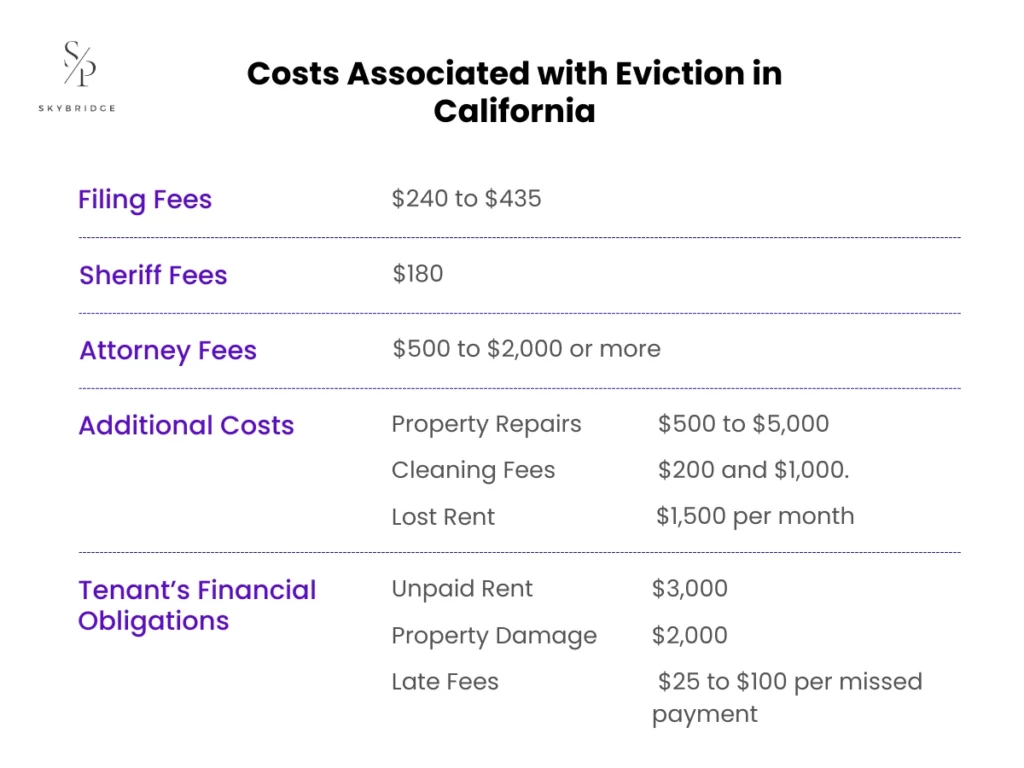
Evicting a tenant in California can cost landlords anywhere from $1,000 to $3,000+, depending on the complexity of the case and the associated legal and enforcement fees. These costs include filing fees, sheriff enforcement fees, attorney fees, and additional costs related to property repairs and unpaid rent. Landlords should be prepared for these expenses, as they can quickly add up throughout the eviction process.
Filing Fees
Filing an unlawful detainer lawsuit is the first step in the legal eviction process, and landlords are required to pay filing fees to initiate the case. These fees range from $240 to $435, depending on the county and the nature of the case. The filing fee covers the costs associated with submitting the complaint for unlawful detainer, summons, and any required civil case cover sheets. Additional fees may apply for subsequent motions, such as filing a request for a Writ of Possession after receiving a judgment.
For example, in Los Angeles County, the filing fee for an unlawful detainer lawsuit costs $385 for claims between $10,000 and $25,000. Landlords can check with the local court for the exact filing fee and whether additional charges may apply based on the specific case or any counterclaims raised by the tenant.
Sheriff Fees
Once a landlord has won the eviction case and received a judgment for possession, the next step involves executing the Writ of Possession with the help of local law enforcement. The sheriff is responsible for physically removing the tenant if they refuse to leave voluntarily. Sheriff fees across California in typically $180, but it may vary depending on the county and the actions required to enforce the eviction.
For example, if the sheriff is required to serve the Notice to Vacate on the tenant, or if the tenant fails to comply and requires a lockout (forced removal), these additional sheriff actions will incur fees. In Los Angeles County, the fee for serving the Writ of Possession and performing the lockout might be $145. However, some counties may offer a lower or higher fee depending on the area’s administrative structure and workload.
Attorney Fees
Attorney fees for eviction cases can range from $500 to $2,000 or more, depending on the complexity of the case and whether the eviction is contested. Simple evictions typically fall at the lower end of the scale, while more complex cases, such as those involving tenant defenses like retaliatory eviction or improper notice, can push costs higher.
For example, in a retaliatory eviction case, the attorney may need to spend additional time gathering evidence, drafting motions, and attending multiple hearings. This added complexity can increase the cost of legal representation, sometimes exceeding $2,000. Landlords should seek attorneys experienced in California Civil Code Section 1946.2 to ensure they follow proper eviction procedures.
Additional Costs
In addition to the core legal fees, landlords may incur additional costs during the eviction process:
- Property Repairs: Costs for repairing damage beyond normal wear and tear, which can range from $500 to $5,000 depending on the extent of the damage.
- Cleaning Fees: If the tenant leaves the property in poor condition, professional cleaning services may cost between $200 and $1,000.
- Lost Rent: Landlords may lose rent while the eviction is pending. For example, if rent is $1,500 per month, this amount could be lost during a prolonged eviction process.
These additional costs can significantly increase the financial burden on landlords, especially when tenants delay the eviction process or cause significant damage to the property.
Tenant’s Financial Obligations
Even after an eviction, tenants may still owe unpaid rent, property damage, and late fees:
- Unpaid Rent: The tenant remains liable for overdue rent. For example, if the tenant owes $3,000 in unpaid rent, the landlord can pursue this through small claims court.
- Property Damage: If the tenant caused damage beyond normal wear and tear (e.g., $2,000 in damages), the landlord can claim these costs in court.
- Late Fees: Tenants may also owe late fees of $25 to $100 per missed payment, as specified in the lease agreement.
In some cases, if the tenant refuses to pay these financial obligations, the landlord can pursue repayment in small claims court. Tenants should be aware that unpaid rent and property damage can lead to legal judgments that remain on their credit report for several years, potentially impacting their ability to rent future properties.
Tenant Rights and Protections in California
In California, tenants are granted several key rights and protections that help prevent unfair evictions. These protections are outlined in state laws, including the California Tenant Protection Act of 2019 (AB 1482), and are reinforced by local ordinances in some cities. These laws ensure that landlords cannot evict tenants without just cause and must follow proper procedures. Below are some of the most important protections for tenants.
Just-Cause Eviction Protection
The California Tenant Protection Act of 2019 (AB 1482) provides Just-Cause Eviction Protection, ensuring that landlords cannot evict tenants without a valid legal reason after they have lived in the rental property for 12 months or more. This protection limits the reasons landlords can use for eviction, helping prevent arbitrary or unfair evictions. Tenants are generally protected from eviction unless the landlord has a legitimate cause as outlined in the law.
Valid reasons for eviction under Just-Cause Protection include:
- Non-payment of rent: The tenant fails to pay rent within the required period.
- Breach of lease: The tenant violates any lease terms, such as unauthorized subletting or bringing pets into a no-pets unit.
- Owner move-in: The landlord or their family member intends to move into the unit.
- Substantial renovation: The property requires significant repairs or remodeling.
- Nuisance: The tenant engages in behavior that disturbs neighbors or violates community rules.
For tenants in rent-controlled areas, such as Los Angeles, additional protections may apply, further limiting eviction reasons and requiring the landlord to offer relocation assistance in certain cases.
Retaliatory Eviction Protection
Under California Civil Code Section 1942.5, retaliatory evictions are prohibited, meaning landlords cannot evict tenants for exercising their legal rights, such as filing complaints about living conditions or requesting necessary repairs. This protection ensures that tenants can freely assert their rights without fear of retaliation, helping maintain a fair rental market.
Common examples of retaliatory eviction include:
- Requesting repairs: A tenant asks the landlord to fix plumbing, heating, or other essential services, and the landlord attempts to evict them shortly afterward.
- Complaining about unsafe conditions: Tenants file complaints with local authorities regarding health or safety violations, prompting the landlord to evict them.
- Exercising rights: Tenants exercising their right to organize a tenant union or seek legal assistance in disputes with their landlord.
Tenants who face retaliatory eviction may contest the eviction in court and, if successful, may be awarded damages, including compensation for legal fees and emotional distress.
Discriminatory Eviction Protection
Discriminatory evictions are prohibited under both California’s Fair Employment and Housing Act (FEHA) and the federal Fair Housing Act, ensuring that tenants cannot be evicted based on characteristics such as race, religion, gender, national origin, disability, or sexual orientation. These protections are vital to ensure fairness and equal treatment in the rental market.
Examples of discriminatory eviction include:
- Eviction based on race, color, or national origin: A landlord evicts a tenant due to their racial or ethnic background.
- Eviction based on gender or sexual orientation: A tenant is evicted because of their gender identity or sexual orientation.
- Eviction based on disability: A landlord evicts a tenant because they have a disability or require accommodations.
Tenants who experience discriminatory eviction can file a complaint with the California Department of Fair Employment and Housing (DFEH) or pursue legal action. Successful cases may result in compensation for damages, including rent refunds or relocation assistance.
COVID-19 Evictions Protections
California enacted temporary COVID-19 eviction protections to prevent tenants from being evicted for non-payment of rent during the pandemic, recognizing that many tenants faced financial hardship due to job loss or illness. While these protections have largely expired, certain tenants may still be eligible for assistance, and the eviction process must still comply with legal requirements.
Key elements of COVID-19 eviction protections included:
- Ban on evictions: Tenants could not be evicted for non-payment of rent if they were financially impacted by COVID-19.
- Documentation of hardship: Tenants were required to provide a declaration of financial hardship due to the pandemic.
- Rental assistance: The state provided funds for tenants to pay overdue rent and avoid eviction.
Although the protections have ended, tenants may still be eligible for rental assistance programs or protections under local ordinances.
Rent Control Ordinances
In cities like San Francisco, Los Angeles, and other urban areas, rent control ordinances limit how much landlords can increase rent each year and provide additional eviction protections. These laws, governed by the California Tenant Protection Act (AB 1482) and local ordinances, are designed to make housing more affordable and protect tenants from excessive rent hikes.
Key elements of rent control ordinances include:
- Rent increase limits: Increases are capped at 5% plus the CPI or 10% of the lowest rent in the past 12 months, whichever is lower. Two increases per year are allowed.
- Annual rent increase: California Tenant Protection Act (AB 1482) limits rent increases to 10% annually, plus a 5% adjustment for local inflation. For San Francisco, the maximum rent increase under AB 1482 for the period from August 1, 2025, to July 31, 2026, is 6.3%.
- Exceptions: Single-family homes, condominiums, and units built after 1995 are exempt under the Costa-Hawkins Act.
- Retaliatory rent increases: Rent increases within 180 days of a tenant exercising their rights (e.g., requesting repairs) are considered retaliatory and illegal.
- Notice requirements: 30-day notice for increases ≤ 10%; 90-day notice for increases > 10%.
- Changes to tenancy terms: Ordinance 175130 prevents landlords from changing tenancy terms without mutual agreement, while Ordinance 174501 restricts rent hikes after ending Section 8 or other rental assistance programs.
How Can Landlords and Tenants Work Together to Avoid Eviction?
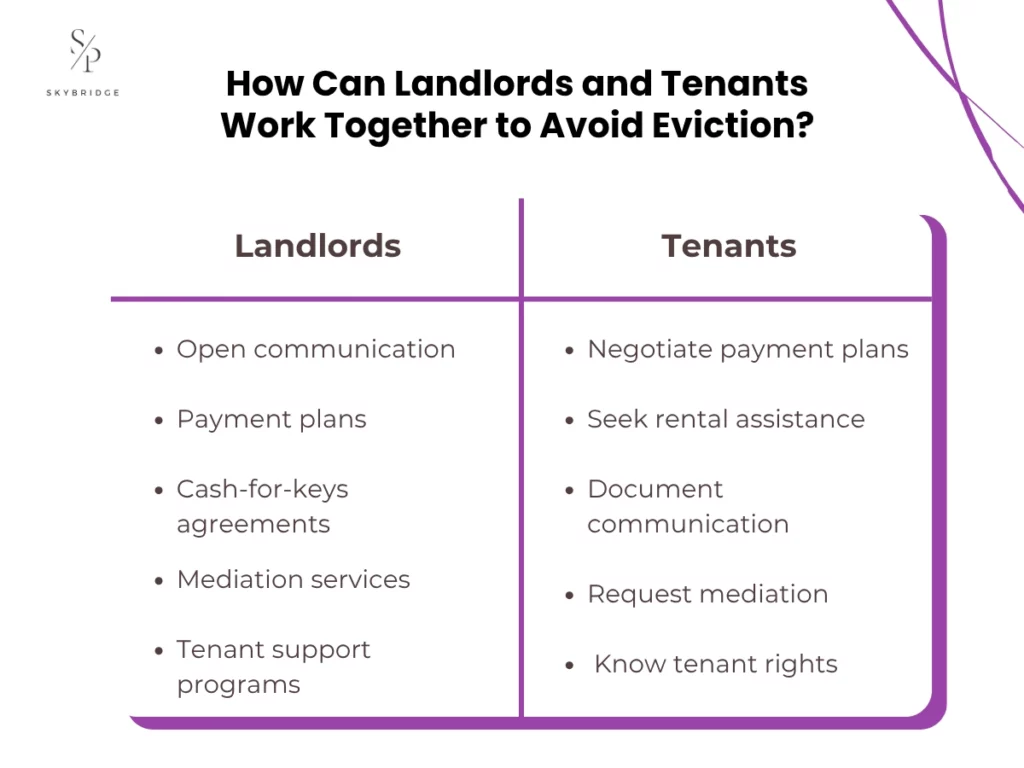
Landlords and tenants can work together to avoid eviction by maintaining open communication, addressing issues early, and exploring alternative solutions. Proactive steps from both parties can help resolve conflicts before they escalate into legal disputes.
What Are Effective Eviction Prevention Strategies for Landlords?
Landlords can prevent eviction by addressing tenant issues early, offering flexible solutions, and maintaining clear, respectful communication. These strategies help build trust and can prevent costly eviction proceedings.
Effective eviction prevention strategies for landlords include:
- Open communication: Regularly check in with tenants and address any concerns promptly to avoid misunderstandings.
- Payment plans: If a tenant is struggling with rent, offering a payment plan can prevent non-payment issues from escalating.
- Cash-for-keys agreements: In cases where eviction is unavoidable, negotiating a cash-for-keys agreement can incentivize tenants to leave voluntarily, saving time and money.
- Mediation services: Mediation can resolve disputes without resorting to formal eviction proceedings, fostering a more cooperative environment.
- Tenant support programs: Providing information on rental assistance programs or local support services can help tenants manage financial challenges.
What Are Effective Eviction Prevention Strategies for Tenants?
Tenants can avoid eviction by staying proactive, understanding their rights, and maintaining open communication with their landlord. Taking steps to resolve issues early can prevent legal conflicts and strengthen the tenant-landlord relationship.
Effective eviction prevention strategies for tenants include:
- Negotiate payment plans: If financial difficulties arise, tenants should negotiate a payment plan with the landlord to avoid falling behind on rent.
- Seek rental assistance: If struggling with rent, tenants can explore rental assistance programs or government resources to avoid eviction.
- Document communication: Keeping records of all communication with the landlord helps ensure a clear understanding and provides evidence if disputes arise.
- Request mediation: Tenants should request mediation services if conflicts arise, allowing for an impartial third party to help resolve issues.
- Know tenant rights: Being informed about tenant rights under California law ensures tenants are aware of protections against unfair eviction practices.
By addressing issues early, both landlords and tenants can maintain a positive relationship and avoid the costly and stressful eviction process.
What are the Common Mistakes in the Eviction Process?
Common mistakes in the eviction process, such as improper notice, failure to follow legal procedures, and self-help evictions, can lead to delays, legal complications, and even invalidation of the eviction. Both landlords and tenants should be aware of these mistakes to ensure the eviction process is carried out correctly.
Common mistakes in the eviction process include:
- Improper notice: Landlords may fail to serve the correct notice or fail to adhere to the required notice period, such as issuing a 3-Day Notice to Pay Rent or Quit without providing the required time to respond.
- Failure to follow legal procedures: Landlords may skip necessary steps, such as filing an unlawful detainer lawsuit after serving a notice, or neglecting to provide proper documentation, leading to an invalid eviction.
- Self-help eviction: Landlords attempting to evict tenants without going through the legal process, such as changing locks or removing tenant belongings, can face legal penalties for illegal eviction under California Civil Code Section 789.
- Not giving enough time for tenant response: In some cases, landlords may not give the tenant sufficient time to respond to the eviction notice or lawsuit, which can cause delays or result in the case being dismissed.
- Improper defenses raised by tenants: Tenants may fail to properly raise valid defenses, such as improper notice or retaliatory eviction, and fail to submit these in time to contest the eviction.
By avoiding these common mistakes and following the required legal procedures, both landlords and tenants can avoid complications and ensure the eviction process is conducted fairly and lawfully.
Get Reliable Eviction Support in California
If you are facing eviction in California, getting reliable support from professionals is crucial to navigating the legal complexities and ensuring your rights are protected. Skybridge Property Group offers comprehensive assistance to both landlords and tenants across California, including Los Angeles, Diamond Bar, Pomona, Long Beach, Orange County, Riverside, and nearby areas, guiding them through the eviction process in full compliance with California laws. From understanding legal procedures to providing access to rental assistance programs and tenant unions, our team ensures that all steps are followed correctly, helping you avoid costly mistakes. Whether you need help with unlawful detainer lawsuits, court hearings, or finding alternative solutions, we provide expert support tailored to your specific situation.

